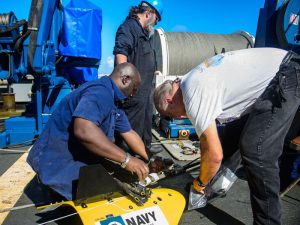
NTSB: Search fails to locate El Faro pinger
The second stage of the search will now start, attempting to find the vessel using side scan sonar.
The USNS Apache arrived at the last known position of the El Faro on October 23, and began searching for the vessel with a Towed Pinger Locator (TPL).
The search area consists of a 10 nautical mile by 15 nautical mile area, in which the USNS Apache towed the TPL on five search lines across the search area in order to detect the acoustic signal associated with the El Faro’s pinger.
The USNS Apache concluded the first phase of the pinger locator search on October 26, 2015, with negative results.
The NTSB says that the TPL’s ability to detect the El Faro’s pinger may be affected by the orientation of the vessel as it lays on the sea floor or the current condition and functionality of the pinger.
The second phase of the search began yesterday, using the Orion side-scan sonar system. The second phase of the search will be conducted over the same search area. This phase will consist of 13 search tracks and will take about 14 days to complete. The side scan sonar system will be used to locate the El Faro, and if found, create an image of the vessel.
If the ship is found on the sea floor, its Voyage Data Recorder or “black box” can be retrieved to help investigators determine the El Faro’s final moments. It is suspected that the ship sank in Hurricane Joaquin on October 1 and is lying on the sea bottom in 15,000 feet of water near the Crooked Islands in the Bahamas. All 33 onboard are presumed lost.
